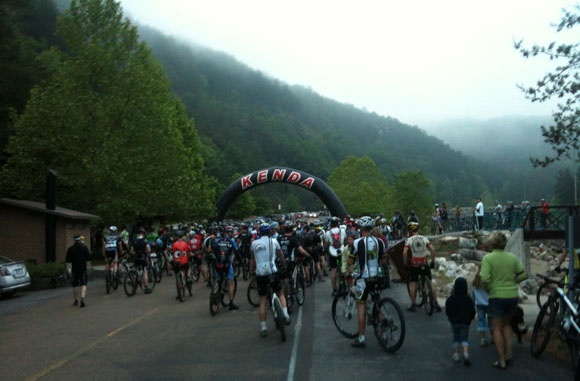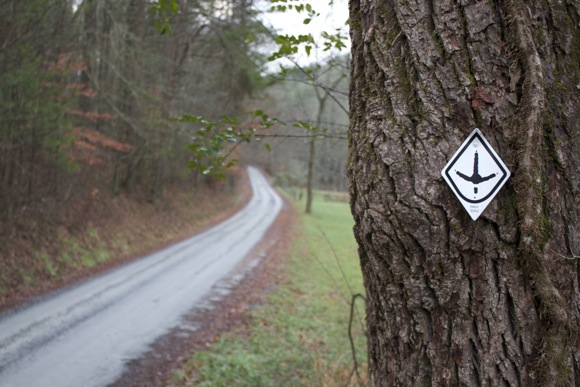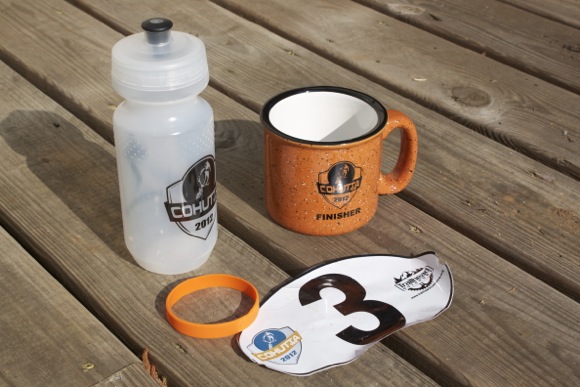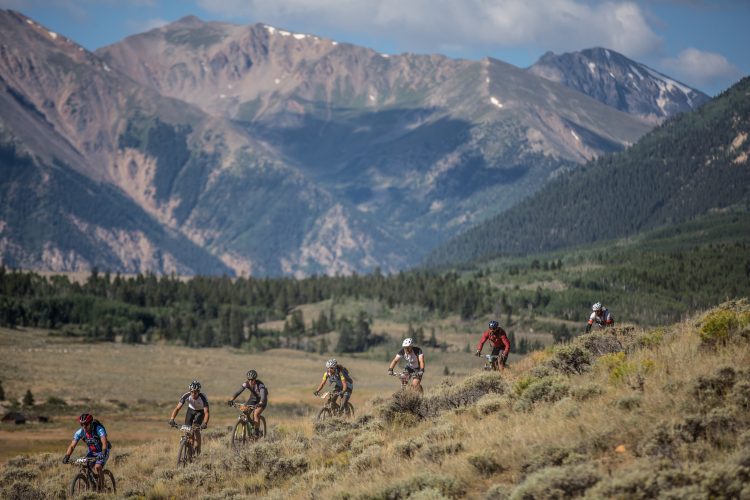This past weekend I completed my first dirty century mountain bike ride – the Cohutta 100 – near Ducktown, TN. It took me nearly 13 grueling hours to finish the 100-mile course with 14,000 feet of climbing but I’m proud to say I am an official finisher! Here’s how my day shook out.
The race started at the Ocoee Whitewater Center in Tennessee, home of the 1996 Olympic canoe, kayak, and slalom events and the Tanasi trailhead. As I nervously prepped my gear in the pre-race darkness I began to second guess whether the sun would actually come up for the race. Thankfully, just before the 7am start, dawn broke and there was an menacing fog in the air. I lined up near the back of the pack and awaited the gun.
For the first 3 miles, the course ran along US Highway 64 with an official police escort to the top of Boyd Gap. This turned out to be a great way to split up the pack ahead of the early singletrack sections and I decided to pass a few folks on the paved climb.
Once we hit the singletrack it was pretty much tire-to-tire for the next 5 or 6 miles – a continuous conga line of mountain bikers stretching at least half a mile front to back. In a few spots the pace would slow down for a rock or a root, causing a ripple down the line. At one point I wasn’t paying attention and the rider in front of me came to a near complete stop. Panicking, I unclipped and put my left foot down, causing a chain reaction of groans and unclipping sounds behind me. Without looking back, I apologized to the rider directly behind me and vowed to stay clipped in and on my bike the rest of the way through the singletrack.
On the trail I noticed tires, CO2, energy bars, water bottles, and multi-tools all over the place, accidentally dropped out of unzipped bags and loose jersey pockets. This made me worry – was my seat bag still zipped? What would I do without my multi-tool? With everyone riding so close together I found it hard to imagine that someone could drop their stuff without the rider directly behind them letting them know. Then again, maybe some of the more competitive riders simply couldn’t afford to double back to pick up their supplies.
Aside from the paved section at the beginning, the first 18 miles was mostly singletrack and the Tansi trails were in great shape. Having all those riders around forced me into a nice pace and made the miles disappear quickly. Before I knew it, we were 23 miles in at aid station #2 and the volunteers did a great job finding drop bags and filling water bottles quickly. From here the route was mostly flat before beginning the first of two very long climbs.
About two-thirds of the way up the first big climb, aid station #3 came into focus and I overheard one of the volunteers saying they were running low on water. This seemed strange since it was so early in the race and everyone would be passing through this aid station again on the return trip. I later decided the volunteer was just kidding – of course they would have enough water – that’s the most important thing about an aid station after all!
After hitting a peak of about 3,600 feet, the fire roads turned down and I began seeing riders at the front of the pack returning up the road I was now descending. The descent seemed steep and with every turn I was dreading the return trip more and more. Many of the pros looked like they were having a tough time which meant I’d be lucky just to make it back.
Aid station #4 was located near the start of the first Pinhoti singletrack section and I was glad to be in familiar territory. Back in December I rode this part of the route so I knew what to expect. The singletrack was amazing and somehow I had the trail to myself – no one in front or behind me the entire way. After descending about 3 miles on the singletrack, I popped out onto the forest road near Mulberry Gap and while cruising on a flat stretch I heard a loud ping: a popped spoke.
This is pretty much the exact spot where my spoke popped (but on a different day).
I have no idea what caused the spoke to break, not that it mattered anyway. I knew riding a wheel with a missing spoke wasn’t a big deal but I wasn’t happy with the fact that I still had 40 miles to go. I wrapped the broken spoke around its nearest neighbor which worked pretty well, except for the fact that it rubbed my brake caliper every time the wheel went around. By the end of the race I had shaved down what felt like an eighth of an inch off the caliper body.
At mile 60 – basically the farthest point out on the course – there were two volunteers handing out wristbands to prove riders hadn’t turned around early. These guys had a great system and were able to slap the wristbands on riders’ outstretched arms in motion.
Back at aid station #4 for the second time (now station #5) I laid down on the ground and it felt great – a little too great. The steepest big climb of the day was ahead and it didn’t help that many of the riders around me were talking about quitting at this point. After several minutes I decided I needed to get going so I started up the climb.
The next 7 miles or so were the toughest of the race and I’m not sure if I spent more time on or off the bike on the way up. Not long after reaching the top of the fire road climb, the course diverted onto another section of the Pinhoti trail that was fast and a lot of fun. I heard several complaints about this “new” course from Cohutta veterans but to me it was great: fire road climbs and singletrack descents (where possible). I was afraid I would be too tired to enjoy the singletrack but it turned out to be a great mental pick-me-up.
Coming out of the singletrack there was a long-ish fire road climb to aid station #6 (same as #3) and along the way I passed several farm houses in the hills. This climb was easily the hottest – full sun and 80 degrees – and both of my water bottles were empty, despite filling both at the last aid station.
As I approached the water cooler, one of the volunteers asked me to only fill one bottle since they were nearly out of water. Uh oh. Luckily I had stashed a bottle of Powerade in my sag bag but another rider beside me wasn’t so lucky and he was LIVID. There was an ambulance standing by but I’m not sure anyone really appreciated the situation. If the water ran out there would be a full-on emergency or at least a mutiny (one rider said he’d quit the race on the spot if they weren’t able to fill his water bottle).
I really wanted to get going to escape the building negative vibe at the aid station but as a bit of parting advice I suggested one of the volunteers (there were at least half a dozen standing around) drive down to one of the houses nearby to look for a spigot. Hopefully they took the advice.
My Strava stats, post ride. Despite clocking 104 miles the course is officially 100 miles long.
At this point I was 75 miles in and the course was mostly downhill from here. I needed to make it to the last aid station as quickly as possible to avoid the cutoff time (I wasn’t sure if it was 6 or 6:30pm). Luckily I made it with time to spare and rested up for the final 13 miles of fire road climbing and singletrack descending.
After about 5 miles on the gravel road, the course finally returned to the Tanasi singletrack but I wasn’t sure how much farther I had to go. My GPS registered 100 miles but I still hadn’t hit the Thunder Rock trail which I knew was the final descent. The riders around me were complaining – this sucks, where is the finish? – but I was focused and trying to stay positive. I surprised myself by navigating the fairly technical singletrack quickly and flawlessly and the next thing I knew, I was within sight of the river and the finish line.
I big-ringed it the rest of the way and crossed the finish line at 12 hours, 46 minutes with little daylight to spare. Mission accomplished!
Back at the car I was completely dehydrated (I weighed about 10 lbs. less than when I started) and I felt pretty sore the next day but otherwise everything turned out ok. Later this month I’ll share my “finisher’s” training plan for those who are thinking about tackling the dirty century beast themselves.

























19 Comments
May 1, 2012
May 1, 2012
Now, all the pre-race info made it clear that hydration was up to each individual and that the aid station stuff was to be considered "supplemental" but how much water can you fit in a 1 gallon sag bag? Maybe next time I should just skip the energy bars and fill my bag with water. :)
@greg: I think my position in the (back of the) race sorta dictated the level of negativity around me. I knew keeping a positive attitude would be key so I really went out of my way to encourage everyone I saw and tried to strike up conversations with the riders around me. Misery loves company but there's only so much you can take before it starts dragging you down.
I was curious about DNFs as well. The results only list finishers and I count 240 of those. The race was sold out @ 300 riders so I guess 60 people either DNF'd or DNS.
@corey: I think Leadville would be too easy. Only 12,600 feet of climbing compared to 14,000 at Cohutta. :)
May 2, 2012
May 2, 2012
May 1, 2012
Excellent points about attitude.
May 1, 2012
May 1, 2012
May 3, 2012
May 2, 2012
May 1, 2012
May 1, 2012
Aug 14, 2012
Jeremiah Bishop: won the Cohutta in 7 hours, 1 minute. Took third at Leadville with 6 hours, 42 minutes. Almost twenty minutes faster at Leadville!
Justin Lindine: fifth place at Cohutta in 7 hours, 35 minutes. Also faster (7 hours, 26 minutes) at Leadville.
So is Leadville an easier course? Perhaps, but the faster times could also be a function of the competition (more fast riders to push everyone to go faster) or the fact that Cohutta is the first race of the season and Leadville is near the end.
Anyone do both this year and want to chime in?
May 3, 2012
May 4, 2012
May 1, 2012
Sucks about the water shortage. I believe there was a new crew running the race this year, guess they just under estimated. That said, it happens to veteran race promoters too. ORAMM ran out of water a year or so ago as well. People actin' a fool doesn't help anything though, especially treating the volunteers like that, it's not their fault, they didn't make the 'how much water do we need' decision.
Again, good job. Big day.
May 1, 2012
Now that you have that mug, it's time to work on a gold belt buckle, if you catch my drift...
May 1, 2012
May 1, 2012
It must have been quite unnerving riding on a broken spoke for 40 miles and it seems pretty cruel to lay in the biggest climb that far into the race--this is clearly not for the ill-prepared!
Not being a racer, I'm not sure about how worthwhile it would be, but on long rides I add a water filter to my pack. Worst case scenario, I can always fill my Camelbak/bottles with fresh, clean water (provided I know there's a reliable water source along the route).
May 2, 2012